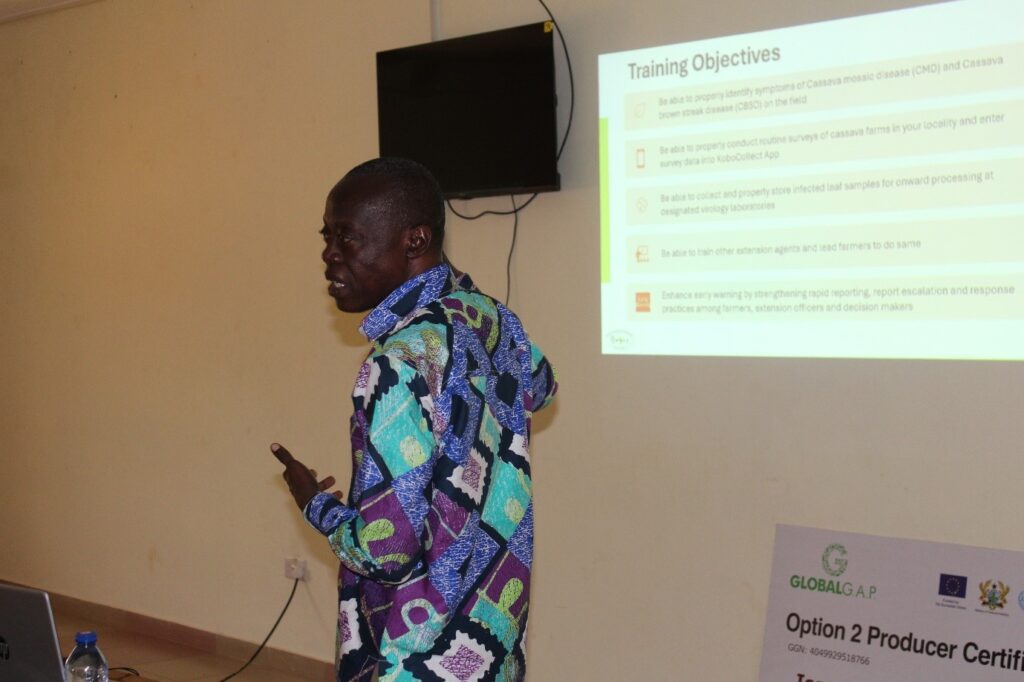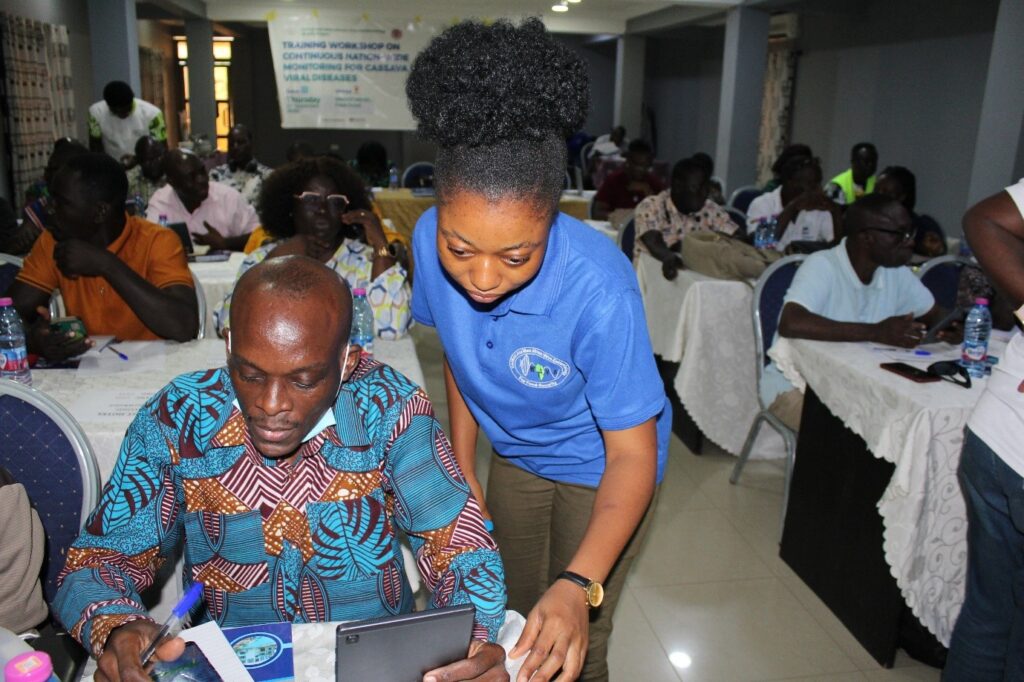WAVE PROJECT TRAINS 170+ TRAINER OF TRAINERS TO STRENGTHEN CASSAVA DISEASE SURVEILLANCE IN GHANA

Cassava plays a vital role in Ghana’s food security and supports millions of livelihoods. However, viral threats like Cassava Mosaic Disease (CMD) and the looming Cassava Brown Streak Disease (CBSD) continue to endanger yields, farmer incomes, and national food supply.
To address this challenge, the Central and West African Virus Epidemiology (WAVE) project, based at the CSIR-Crops Research Institute (CSIR-CRI), has launched a nationwide training initiative to boost cassava disease detection and monitoring across Ghana.

Over 170 extension officers, and plant health specialists who play critical roles in early detection and management of plant diseases from over 40 municipalities and districts, across 15 regions participated in four intensive training workshops held at Goaso (Ahafo Region), Somanya (Eastern Region), Cape Coast (Central Region), and Tamale (Northern Region).

Training Focus: Building Competence for Real-Time Surveillance
The training sessions were designed to be immersive and practice-oriented. Across all four locations, participants were trained to:
- properly identify symptoms of Cassava mosaic disease (CMD) and Cassava brown streak disease (CBSD) on the field
- properly conduct routine surveys of cassava farms in their localities and enter survey data into KoboCollect App
- collect and properly store infected leaf samples for onward processing at designated virology laboratories
- train other extension agents and lead farmers
- enhance early warning by strengthening rapid reporting, report escalation and response practices among farmers, extension officers and decision makers
The training sessions were led by Dr. Allen Oppong, a Principal Research Scientist at the CSIR-CRI and Ghana Country Director of the WAVE project. Dr. Oppong encouraged participants to apply their new skills within their respective districts to strengthen plant health surveillance and safeguard Ghana’s cassava sector. “By spreading this training across four strategic locations, we’re ensuring that capacity-building is truly national and accessible to all frontline actors,” he said.

According to Oppong, the goal was not only to transfer knowledge but also to build a sustainable national network for plant health surveillance. “Our goal is to improve cassava productivity by addressing viral diseases that impede yields. By training officers to collect accurate data, we can quickly detect emerging diseases, prevent outbreaks, and safeguard both farmers’ incomes and national food security,” he stated.


He highlighted two major cassava diseases Cassava Mosaic Disease (CMD) and Cassava Brown Streak Disease (CBSD). CMD which is already widespread in Ghana and across West Africa, attacks the leaves of plants, reducing photosynthesis and eventually affecting root development, which leads to reduced yields. On the other hand, the more devastating CBSD, though not yet present in the sub-region, but spreading from Central and East Africa, destroys the root itself, making it completely unusable.
Technology at the Heart: Kobocollect Mobile Application

A major component of the training at all four locations was the demonstration and hands-on practice with the Kobocollect mobile application, an innovative digital tool designed to transform disease monitoring. This tool enables acccurate disease identification using guided forms and image references, GPS-enabled mapping of infected fields, real-time data uploading to a central database, enabling national-scale monitoring, timely decision-making and rapid intervention.
Hands-on sessions demonstrated how participants can log suspected cases, attach photos, and generate automated location maps for disease hot spots. Participants were encouraged to integrate this tool into their day-to-day fieldwork.

Mr. Kingsford Nyame, Regional Director of Agriculture in the Ahafo region, commented: “The real-time data collection system will significantly reduce our response time and improve our ability to protect farmers’ livelihoods. For the first time, we can view data from across the country as it’s being collected.”
Regional Highlights and Voices from the Field
Goaso – Ahafo Region

The first workshop, hosted at the Regional Department of Agriculture in Goaso, focused on the Ashanti, Ahafo, Western North and Bono regions, where cassava cultivation is widespread. Participants were drawn from over thirteen (13) districts. They conducted mock field surveys in a nearby community using their mobile phones to record and transmit data.
Dr. Ruth Prempeh, a Senior Research Scientist at the CSIR-CRI and a member of the WAVE project, indicated that cassava was not only a staple food but also an economic and industrial crop and therefore protecting it from viral diseases was key to safeguarding the country’s future.
Ms. Afua Mensah, an Extension Officer from Ahafo South, remarked: “This training has equipped us with practical tools to quickly identify and report cassava diseases. For the first time, we can upload data directly from the field and receive instant feedback from national experts.”
Somanya-Eastern Region.

The second workshop held at the Yilo Krobo Mango Farmers Association Resource Centre in Somanya drew participants from the Greater Accra, Eastern and Volta regions. Here, facilitators emphasized data-driven decision-making and the use of geo-tagging to create a “map” of cassava disease hotspots. Participants practiced differentiating CMD and CBSD symptoms and received instruction on sample preservation for laboratory confirmation.
Miss Esther Afoley Annan, an assistant research scientist at the CSIR-CRI and member of the WAVE project team, was very hopeful that participants would transfer the knowledge gained during the training to farmers as well as other stakeholders.
Cape Coast-Central Region

The third session at Cape Coast in the Central Region catered to officers from the Central and Western regions. Sessions highlighted community-based approaches to cassava disease surveillance, empowering extension agents to integrate local farmers into early detection and rapid response systems. Participants also received training in farmer-led demonstrations, where farmers themselves can record disease symptoms using simplified Kobocollect templates.
Mr. Daniel Kafui, an extension agent from Cape Coast remarked: “I am excited to involve our farmer-based organizations in disease monitoring. The Kobocollect app is simple enough for us to train farmer leaders to use.”
Tamale-Northern Region

The fourth and final workshop focused on officers from the Northern, Oti, Savannah and the Upper West region of Ghana.
Dr. Allen Oppong emphasized: “This training brings the science directly to the field. With these skills, our extension staff can act as the first line of defense against emerging cassava threats.” Tamale’s participants also explored strategies for linking local farmer-based organizations with national surveillance systems — a crucial step for early warning in hard-to-reach areas.
Conclusion
By bringing together over 170 stakeholders across fifteen regions, equipping them with cutting-edge digital tools, and fostering collaboration across institutional boundaries, the WAVE project has taken a decisive step towards securing Ghana’s cassava industry.
“We now have a nationwide network of trained officers ready to act as the eyes and ears of the country’s cassava sector,” said Dr. Oppong. “With their skills and commitment, Ghana is better prepared to prevent and manage cassava viral diseases.”
About the WAVE Project
The Central and West African Virus Epidemiology (WAVE) project is a regional initiative aimed at strengthening plant health surveillance systems, improving early detection and response to plant diseases, and promoting the use of technology and innovation in agriculture. Operating in more than 10 countries including Nigeria, Benin, Togo, Cameroon, Ghana, Congo, Gabon, Burkina Faso, Sierra Leone, and Côte d’Ivoire, with its headquarters in Abidjan. WAVE brings together research institutions, government agencies, and farming communities to build resilient agricultural systems and enhance food security across West and Central Africa through coordinated viral disease management.
Authors: Bernard Sakyiamah, Allen Oppong, Enoch Bobie Agyemang, Dennis Gyasi Boakye
